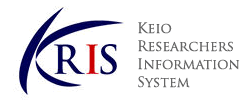-
Affiliation
-
Faculty of Science and Technology, Department of Biosciences and Informatics (Yagami)
-
Position
-
Professor
-
Related Websites

KEIO RESEARCHERS INFORMATION SYSTEM |
Details of a Researcher
このページはJavascriptを使用しています。すべての機能を使用するためにはJavascript を有効にする必要があります。
Sakakibara, Yasubumi
|
|
|
(株)富士通研究所情報社会科学研究所 ,研究員
兼 米国カリフォルニア大学サンタクルーズ校 ,客員研究員
東京電機大学理工学部情報科学科 ,助教授
東京電機大学理工学部情報科学科 ,教授
慶應義塾大学理工学部生命情報学科 ,助教授
Tokyo Institute of Technology, Faculty of Science, 情報科学科
University, Graduated
Tokyo Institute of Technology, Graduate School, Division of Science and Engineeri, 情報科学専攻
Graduate School, Completed, Master's course
Life Science / System genome science
Informatics / Life, health and medical informatics (Bioinformatics)
Big daya analysis,
Cancer genmome analysis,
functional RNA sequence analysis,
情報数理シリーズ「計算論的学習」
榊原康文,小林聡,横森貴, 培風館, 2001.10
DNAコンピューティング
Paun, Rozenberg, Salomaa 著,横森貴, 榊原康文, 小林聡 訳, シュプリンガー・フェアラーク東京, 1999.12
新版 情報処理ハンドブック
情報処理学会偏,13編6章の「学習」に関する節を分担執筆, オーム社, 1995.11
Uehara M., Inoue T., Hase S., Sasaki E., Toyoda A., Sakakibara Y.
mSystems (mSystems) 9 ( 5 ) 2024.05
Ochiai T., Inukai T., Akiyama M., Furui K., Ohue M., Matsumori N., Inuki S., Uesugi M., Sunazuka T., Kikuchi K., Kakeya H., Sakakibara Y.
Communications Chemistry (Communications Chemistry) 6 ( 1 ) 2023.12
Automatic Detection and Measurement of Renal Cysts in Ultrasound Images: A Deep Learning Approach
Kanauchi Y., Hashimoto M., Toda N., Okamoto S., Haque H., Jinzaki M., Sakakibara Y.
Healthcare (Switzerland) (Healthcare (Switzerland)) 11 ( 4 ) 2023.02
Quantum Algorithm for Position Weight Matrix Matching
Miyamoto K., Yamamoto N., Sakakibara Y.
IEEE Transactions on Quantum Engineering (IEEE Transactions on Quantum Engineering) 4 2023
Hu M., Asami C., Iwakura H., Nakajima Y., Sema R., Kikuchi T., Miyata T., Sakamaki K., Kudo T., Yamada M., Akamizu T., Sakakibara Y.
Communications Medicine (Communications Medicine) 2 ( 1 ) 2022.12
Analysis and control of cell function based on novel glycomics using saccharide primer method
Sakakibara, Yasubumi
科学研究費補助金研究成果報告書 2015
Exploitation of pathogenic gastrointestinal bacteria specific molecular targeting therapy
Sakakibara, Yasubumi
科学研究費補助金研究成果報告書 2015
Comprehensive analysis of functional non-coding RNAs in cancer genome on multistage carcinogenesis
Sakakibara, Yasubumi
科学研究費補助金研究成果報告書 2014
Mechanisms of the development of neuronal cell community in the central nervous system
Sakakibara, Yasubumi
科学研究費補助金研究成果報告書 2013
Mechanisms of the development of neuronal cell community in the central nervous system
Sakakibara, Yasubumi
科学研究費補助金研究成果報告書 2010
Guest Editorial for the 16th Asia Pacific Bioinformatics Conference
Yamanishi Y., Sakakibara Y., Chen Y.
IEEE/ACM Transactions on Computational Biology and Bioinformatics (IEEE/ACM Transactions on Computational Biology and Bioinformatics) 16 ( 1 ) 2019.01
ISSN 15455963
MetaVelvet : An extension of Velvet assembler to de novo metagenome assembly from short sequence reads
Namiki, T., Hachiya, T., Tanaka, H., and SAKAKIBARA YASUBUMI
ACM Conference on Bioinformatics, Computational Biology and Biomedicine 2011 (Chicago, USA) ,
Oral presentation (general)
Comprehensive analysis of small non-coding RNAs in medaka transcriptome by deep RNA-seq approach
Abe, M., Hase, S., Ogawa, M., Okada, Y., Sato, K., Saito, Y., and SAKAKIBARA YASUBUMI
RNA 2011 Sixteenth Annual Meeting of the RNA Society (Kyoto, Japan) ,
Oral presentation (general)
Genome-wide detections of non-coding RNAs on Ciona intestinalis genome: from in silico search of snoRNA to full-length sequencing and expression analysis
Kawarama, J., Hase, S., Hachiya, T., Hotta, K., Sakakibara, Y.
5th International Tunicate Meeting (Okinawa, Japan) ,
Oral presentation (general)
Discriminative Detection of Cis-acting Regulatory Variation from Location Data
Yuji Kawada, Yasubumi Sakakibara
The 4th Asia-Pacific Bioinformatics Conference (APBC2006), Taiwan (Taiwan) ,
Oral presentation (general)
Intensive in vitro experiments of implementing and executing finite automata in test tube
Junna Kuramochi and Yasubumi Sakakibara
The 11th International Meeting on DNA Based Computers (DNA11), London, Ontario (London, Ontario) ,
Oral presentation (general)
Construction of chemical latent space using deep learning and design of artificial molecular structures
学術変革領域研究(A), Principal investigator
Genomic-style feature extraction and de novo design and synthesis of DNA sequence using deep learning
JST, CREST, Commissioned research, Principal investigator
非コードRNA遺伝子をゲノムワイドに発見する汎用システム
MEXT,JSPS, Grant-in-Aid for Scientific Research, Grant-in-Aid for Scientific Research (A) , Principal investigator
Deep analysis of chemical communication space using artificial intelligence technology
MEXT,JSPS, Grant-in-Aid for Scientific Research, Grant-in-Aid for Scientific Research on Innovative Areas, Principal investigator
ビッグデータ駆動型創薬システム研究拠点
戦略的研究基盤形成支援事業, Principal investigator
核酸分子を用いた新規な情報解析方法およびそれを用いた核酸の解析方法
Date applied: 特願2000-382449 2000.12
Patent
Data Sorting,Data Sorting Tree Creating,Derivative
Date issued: United State Patent,No.5787426 1998.07
Patent
東京電機大学研究振興会 教育奨励賞
榊原 康文, 1999, 東京電機大学研究振興会, 「プログラム言語のマルチメディア教育」
TOPICS IN SYSTEMS BIOLOGY
2024
TOPICS IN BIOSCIENCES AND INFORMATICS 1
2024
SEMINAR IN BIOSCIENCES AND INFORMATICS
2024
METHODOLOGY FOR POST-GENOME BIOSCIENCES
2024
INTRODUCTION TO BIOLOGY TODAY
2024
Bioinformatics
Keio University
Spring Semester, Lecture, Lecturer outside of Keio, 50people
基礎生命実験
Keio University
Autumn Semester, Laboratory work/practical work/exercise, Outside own faculty (within Keio), 50people
システムバイオロジー特論
Keio University
Autumn Semester, Lecture, Outside own faculty (within Keio), 50people
BioProgramming 2
Keio University
Autumn Semester, Lecture, Lecturer outside of Keio, 50people
Algorithm and Information processing
Keio University
Autumn Semester, Lecture, Within own faculty, 50people
第8回 新しい RNA/RNP を見つける会
6th International Workshop on Algorithmic Learning
(財)新世代コンピュータ技術開発機構 蛋白質立体構造予測タスクグループ
2nd,3rd,4th,5th,6th International Colloquium on Gr
5th,7th,8th,9th,11th International Workshop on Alg
16th International Conference on DNA Computing and Molecular Programming,
20th International Conference on Genome Informatics(GIW2009),
人工知能学会 人工知能基礎論研究会,
情報処理学会 論文誌編集委員会,
第44回情報処理学会全国大会 チュートリアルセッション 機械学習入門,
Program Committee Co-Chairman, 16th International Conference on DNA Computing and Molecular Programming
organizing chairman, 20th International Conference on Genome Informatics(GIW2009)
Committee Chair, 第8回 新しい RNA/RNP を見つける会
幹事, 人工知能学会 人工知能基礎論研究会
委員, 情報処理学会 論文誌編集委員会